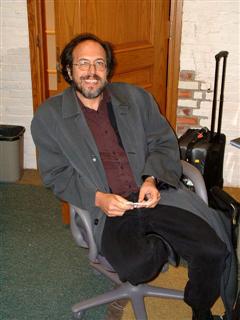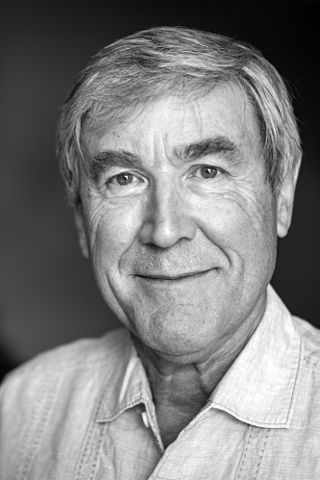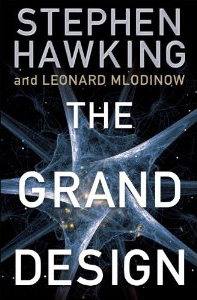
The Big Bang is a physical theory that describes how the universe expanded from an initial state of high density and temperature. It was first proposed in 1931 by Roman Catholic priest and physicist Georges Lemaître when he suggested the universe emerged from a "primeval atom". Various cosmological models of the Big Bang explain the evolution of the observable universe from the earliest known periods through its subsequent large-scale form. These models offer a comprehensive explanation for a broad range of observed phenomena, including the abundance of light elements, the cosmic microwave background (CMB) radiation, and large-scale structure. The overall uniformity of the universe, known as the flatness problem, is explained through cosmic inflation: a sudden and very rapid expansion of space during the earliest moments. However, physics currently lacks a widely accepted theory of quantum gravity that can successfully model the earliest conditions of the Big Bang.

Lee Smolin is an American theoretical physicist, a faculty member at the Perimeter Institute for Theoretical Physics, an adjunct professor of physics at the University of Waterloo, and a member of the graduate faculty of the philosophy department at the University of Toronto. Smolin's 2006 book The Trouble with Physics criticized string theory as a viable scientific theory. He has made contributions to quantum gravity theory, in particular the approach known as loop quantum gravity. He advocates that the two primary approaches to quantum gravity, loop quantum gravity and string theory, can be reconciled as different aspects of the same underlying theory. He also advocates an alternative view on space and time that he calls temporal naturalism. His research interests also include cosmology, elementary particle theory, the foundations of quantum mechanics, and theoretical biology.
Frank Jennings Tipler is an American mathematical physicist and cosmologist, holding a joint appointment in the Departments of Mathematics and Physics at Tulane University. Tipler has written books and papers on the Omega Point based on Pierre Teilhard de Chardin's religious ideas, which he claims is a mechanism for the resurrection of the dead. He is also known for his theories on the Tipler cylinder time machine. His work has attracted criticism, most notably from Quaker and systems theorist George Ellis who has argued that his theories are largely pseudoscience.

Paul Charles William Davies is an English physicist, writer and broadcaster, a professor in Arizona State University and director of BEYOND: Center for Fundamental Concepts in Science. He is affiliated with the Institute for Quantum Studies in Chapman University in California. He previously held academic appointments in the University of Cambridge, University College London, University of Newcastle upon Tyne, University of Adelaide and Macquarie University. His research interests are in the fields of cosmology, quantum field theory, and astrobiology.
The characterization of the universe as finely tuned intends to explain why the known constants of nature, such as the electron charge, the gravitational constant, and the like, have their measured values rather than some other arbitrary values. According to the "fine-tuned universe" hypothesis, if these constants' values were too different from what they are, "life as we know it" could not exist. In practice, this hypothesis is formulated in terms of dimensionless physical constants.

Lawrence Maxwell Krauss is a Canadian-American theoretical physicist and cosmologist who taught at Arizona State University (ASU), Yale University, and Case Western Reserve University. He founded ASU's Origins Project in 2008 to investigate fundamental questions about the universe and served as the project's director.
Creationex materia refers to the notion that the universe was formed out of eternal, pre-existing matter. This is in contrast to the notion of creation ex nihilo, where the universe is created out of nothing. The idea of creation ex materia is already found in ancient near eastern cosmology.

David Z. Albert is Frederick E. Woodbridge Professor of Philosophy and Director of the MA Program in The Philosophical Foundations of Physics at Columbia University in New York.

The Kalam cosmological argument is a modern formulation of the cosmological argument for the existence of God. It is named after the Kalam, from which its key ideas originated. William Lane Craig was principally responsible for giving new life to the argument in the 20th century, due to his book The Kalām Cosmological Argument (1979), among other writings.
Edward P. Tryon was an American scientist and a professor emeritus of physics at Hunter College of the City University of New York (CUNY). He was the first physicist to propose that our universe originated as a quantum fluctuation of the vacuum.

Quantum mysticism, sometimes referred pejoratively to as quantum quackery or quantum woo, is a set of metaphysical beliefs and associated practices that seek to relate consciousness, intelligence, spirituality, or mystical worldviews to the ideas of quantum mechanics and its interpretations. Quantum mysticism is considered pseudoscience and quackery by quantum mechanics experts.

Michał Kazimierz Heller is a Polish philosopher, theoretical physicist, cosmologist, theologian, and Roman Catholic priest. He is a professor of philosophy at the Pontifical University of John Paul II in Kraków, Poland, and an adjunct member of the Vatican Observatory staff.

Sean Michael Carroll is an American theoretical physicist and philosopher who specializes in quantum mechanics, cosmology, and philosophy of science. Formerly a research professor at the Walter Burke Institute for Theoretical Physics at the California Institute of Technology (Caltech) department of physics, he is currently an external professor at the Santa Fe Institute, and the Homewood Professor of Natural Philosophy at Johns Hopkins University. He has been a contributor to the physics blog Cosmic Variance, and has published in scientific journals such as Nature as well as other publications, including The New York Times, Sky & Telescope and New Scientist. He is known for his atheism, his vocal critique of theism and defense of naturalism. He is considered a prolific public speaker and science populariser. In 2007, Carroll was named NSF Distinguished Lecturer by the National Science Foundation.

Everything, every-thing, or every thing, is all that exists; it is an antithesis of nothing, or its complement. It is the totality of things relevant to some subject matter. Without expressed or implied limits, it may refer to anything. The universe is everything that exists theoretically, though a multiverse may exist according to theoretical cosmology predictions. It may refer to an anthropocentric worldview, or the sum of human experience, history, and the human condition in general. Every object and entity is a part of everything, including all physical bodies and in some cases all abstract objects.
The zero-energy universe hypothesis proposes that the total amount of energy in the universe is exactly zero: its amount of positive energy in the form of matter is exactly canceled out by its negative energy in the form of gravity. Some physicists, such as Lawrence Krauss, Stephen Hawking or Alexander Vilenkin, call or called this state "a universe from nothingness", although the zero-energy universe model requires both a matter field with positive energy and a gravitational field with negative energy to exist. The hypothesis is broadly discussed in popular sources. Other cancellation examples include the expected symmetric prevalence of right- and left-handed angular momenta of objects, the observed flatness of the universe, the equal prevalence of positive and negative charges, opposing particle spin in quantum mechanics, as well as the crests and troughs of electromagnetic waves, among other possible examples in nature.

The Grand Design is a popular-science book written by physicists Stephen Hawking and Leonard Mlodinow and published by Bantam Books in 2010. The book examines the history of scientific knowledge about the universe and explains eleven-dimensional M-theory. The authors of the book point out that a Unified Field Theory may not exist.

Why Does the World Exist?: An Existential Detective Story is a nonfiction work authored by Jim Holt. He and the book were on the LA Times bestseller list during the last quarter of 2012, and the first quarter of 2013. The book was also a 2012 National Book Critics Award finalist for nonfiction.

Quintessence: The Search for Missing Mass in the Universe is the fifth non-fiction book by the American theoretical physicist Lawrence M. Krauss. The book was published by Basic Books on December 21, 2000. This text is an update of his 1989 book The Fifth Essence. It was retitled Quintessence after the now widely accepted term for dark energy.

"Why is there anything at all?" or "why is there something rather than nothing?" is a question about the reason for basic existence which has been raised or commented on by a range of philosophers and physicists, including Gottfried Wilhelm Leibniz, Ludwig Wittgenstein, and Martin Heidegger, who called it "the fundamental question of metaphysics".

The Greatest Story Ever Told—So Far: Why Are We Here? is the tenth full-length non-fiction book by the American theoretical physicist Lawrence M. Krauss. The book was initially published on March 21, 2017 by Atria Books.














